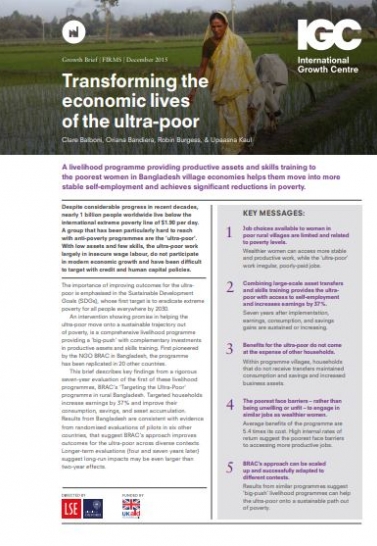IGC. (2015). Transforming the Economic Lives of the Ultra Poor. London: International Growth Centre.
Summary:
Despite considerable progress in recent decades, nearly 1 billion people worldwide live below the international extreme poverty line of $1.90 per day. A group that has been particularly hard to reach with anti-poverty programmes are the ‘ultra-poor’. With low assets and few skills, the ultra-poor work largely in insecure wage labour, do not participate in modern economic growth and have been difficult to target with credit and human capital policies.
This brief describes key findings from a rigorous seven-year evaluation of the first livelihood programme targeting this group, BRAC’s ‘Targeting the Ultra-Poor’ programme in rural Bangladesh. It also includes recommendations for policymakers and future research.
Key Messages:
- Job choices available to women in poor rural villages are limited and related to poverty levels. Wealthier women can access more stable and productive work, while the ‘ultra-poor’ work irregular, poorly-paid jobs.
- Combining large-scale asset transfers and skills training provides the ultrapoor with access to self-employment and increases earnings by 37%. Seven years after implementation, earnings, consumption, and savings gains are sustained or increasing.
- Benefits for the ultra-poor do not come at the expense of other households. Within programme villages, households that do not receive transfers maintained consumption and savings and increased business assets.
- The poorest face barriers – rather than being unwilling or unfit – to engage in similar jobs as wealthier women. Average benefits of the programme are 5.4 times its cost. High internal rates of return suggest the poorest face barriers to accessing more productive jobs.
- BRAC’s approach can be scaled up and successfully adapted to different contexts. Results from similar programmes suggest ‘big-push’ livelihood programmes can help the ultra-poor onto a sustainable path out of poverty

